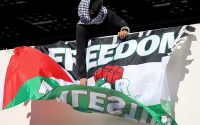The protest appears to be gathering pace |
Up to 20,000 people took to the streets on the seventh day of protests calling for an end to the "evil dictatorship".
Unlike a day earlier, police barred a group of monks from entering the road that leads to the home of detained opposition leader Aung San Suu Kyi.
The rallies began last month when the government doubled fuel prices.
BBC South East Asia correspondent Jonathan Head says every day the protests are growing in size - the campaign the monks began just six days ago is now openly challenging the military, urging all citizens to join in.
Barricades
A huge column of demonstrators made its way through the heart of the city, following an identical route to that used during the failed anti-military uprising in 1988.
There are no exact figures but the rally was estimated to be 20,000 strong.
 Ms Suu Kyi can be seen behind the police greeting protesters |
Our correspondent says the mood was relaxed, even euphoric, with thousands of civilians joining Buddhist monks and nuns, and chanting the key demands of this campaign - reconciliation with the opposition, the release of political prisoners and lower prices.
Apparently unsure what to do, the security forces appear to be standing back for the moment and the next act in the drama is impossible to predict, says our correspondent.
Speaking on the sidelines of a UN meeting, US Secretary of State Condoleezza Rice said America was "watching very carefully" the protests and denounced Burma's "brutal regime".
"The Burmese people deserve better. They deserve the right to be able to live in freedom, just as everyone does."
The head of regional grouping Asean, Ong Keng Yong said he hoped the Burmese authorities would not take any strong action "and turn the protests into a big confrontation".
Ms Suu Kyi emerged tearfully on Saturday from the home where she has been under house arrest since 2003 to pray with the monks, after they were allowed through a roadblock.
But on Sunday the barricades were firmly back in place and there was a heavy security presence near the democracy icon's home to prevent a repeat protest march past.
Prayer vigils
Witnesses said the crowds formed a protective human chain, as the monks and nuns set off from Burma's most famous landmark, the revered Shwedagon Pagoda.
 |
Some demonstrators chanted "Release Suu Kyi" as they continued to the nearby Sule Pagoda, before passing the US embassy.
Nobel Peace Prize Laureate Ms Suu Kyi has spent 11 of the last 18 years in detention.
In 1990 her party won national elections, but these were annulled by the army and she was never allowed to take office.
On Friday, the Alliance of All Burmese Buddhist Monks, which is leading the demonstrations, vowed to continue until they had "wiped the military dictatorship from the land".
The monks have urged the Burmese people to hold prayer vigils in their doorways for 15 minutes at 2000 (1330 GMT) on Sunday, Monday and Tuesday.
Scores of nuns joined more than 2,000 monks in prayer on Sunday at the Shwedagon Pagoda, before marching to the centre of Rangoon.







